Alvis
|
1919 - 1967 |
Country: |
 |
|
Coventry, England. Home of many great Marques, but one lesser known (particularly for many Australian’s) is the Alvis. Alvis was founded by T G John, who created the company to produce
automobile engines, casting for carburettors, and motor scooters.
John himself was originally a naval architect, who became chief engineer of Siddeley-Deasy, in 1915, where aeroplane engines were to be made. The companies initial success was due in no small part to one G.P.H. de Freville, responsible for the importation to Britain of DFP cars before
W.O. Bentley took on that concession.
Not only did Freville design the engine for the very first Alvis car, th 10/30 of 1920, but he also invented the marque name Alvis. We have found several sources that contest th name carried no more significance than that it rolled nicely off the tongue!
Straight up, the first Alvis (10/30 model) was of a sporting nature. Able to reach the then holy grail speed of 60mph using only a 1.5 litre engine, far superior to most of its rivals. A Super Sports version was well received, and this featured the 'duck's back' body styl for which Alvis cars later became famous.
In 1923 the 12/50 model was announced, and this achieved instant fame when most every example won the “Junior Car Club” 200 mile race at
Brooklands - at an astonishing 93.3 mph! Road-equipped cars, even then were capable of 70 mph. The 12/50's new pushrod overhead valve engine was designed by Captain G T Smith-Clarke, who had arrived as chief engineer from Daimler, and his chief draughtsman was W M Dunn, who later succeeded him.
Between them, they were responsible for all but the very last Alvis private cars. Some 600 cars would be sold in 1924, the 12/50 type engine being used in every one. But Alvis were not prepared to stand on past glory, and set about a rigorous regime of engineering improvement – so much so that the two-seater models of 1927 were “guaranteed” capable of 60 mph.
Unfortunately (we can easily say this with hindsight) the duck's back models were quickly losing popularity, and were produced in fewer numbers. Still, at Unique Cars and Parts we understand that if not for the folly of popular taste in any given era, or indeed the foibles of the less than exceptional, some cars would never today be considered a “Classic” or highly collectable.
In 1925 an experimental front-wheel drive racing Alvis was produced, where the 12/60 engine was used. This
prototype set the fastest time of the day at the Shelsley Walsh Hill-climb that year. Alvis became so addicted to
front wheel drive that they even built special eight-cylinder racing models, although none of these were particularly successful. But from our research, we will contest that they were the first company to bring a
front wheel drive sports car to market, perhaps current owners of the Mazda MX-5 owe a little of their cars heritage to Alvis? (then again, perhaps that is rather too fanciful!). In any case, these front-wheelers turned out to be both extremely troublesome and expensive (only 155 were built) compared with 9000 conventional Alvises built up to 1932.
Even though the first six-cylinder Alvis was launched in 1928, the successful 12/50 refused to die, and though withdrawn once, it was quickly reintroduced. In 1931 a twin-carburettor version known as the 12/60 was also offered, this usually having “beetle back” bodywork, where there was an extra 'dickey' seat hidden away in the rear bodywork. All the 12/50s and 12/60s were lively and fun to drive, strong and reliable. We are told many UK examples survive to this day. Meantime the six-cylinder Alvis line was developed, with a touring Silver Eagle model being given a 2.5 litre version in 1931. Later that year, the 2.5 litre was introduced to the new “Speed Twenty”.
While today most car manufacturers boast of years of research and seemingly unlimited design and development budgets assigned to any new model, in 1931 Alvis were to boast that, under the stewardship of Smith-Clarke, the Speed Twenty was produced from drawing board to reality in a mere 14 weeks! Alvis would never manufacture their own body shells, preferring to use those manufactured by leading design houses such as Vanden Plas, Vanden Plas, Charlesworth, Mayfair, Cross & Ellis, or Thrupp & Maberly. Whichever body style chosen by the Alvis purchaser, they could be assured their Speed Twenty would be good for 90 mph, particularly after the car was upgraded to a 2.76 litre in 1935.
When the engine was again upgraded, this time to a 3.57 litre engine, Alvis renamed the car the “Speed Twenty Five”. But arguably the most exciting Alvis of the 1930’s was the 4.3 litre, announced in 1937. This was one of very few cars of the day capable of a genuine 100 mph, boasting a whopping 137bhp in standard form, while up to 170bhp could be extracted from race-prepared units.
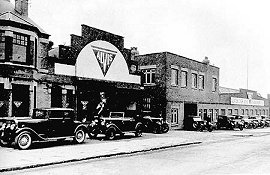 The Alvis Factory, Holyhead Road, circa 1930.
The Alvis Factory, Holyhead Road, circa 1930.
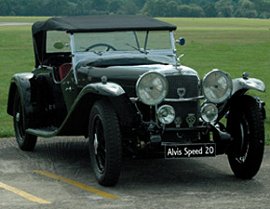 Alvis boasted the "Speed 20" was developed in a mere 14 weeks.
Alvis boasted the "Speed 20" was developed in a mere 14 weeks.
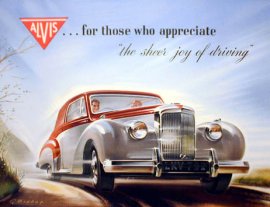 Alvis - for those who appreciate "the sheer joy of driving".
Alvis - for those who appreciate "the sheer joy of driving".
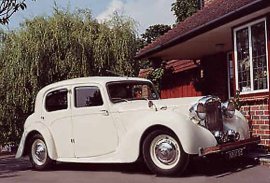 Only 3000 TA14 Saloon's would be built between 1946 and 1950, no doubt due to the devastation wreaked on the Alvis factory during the Blitzkreig.
Only 3000 TA14 Saloon's would be built between 1946 and 1950, no doubt due to the devastation wreaked on the Alvis factory during the Blitzkreig.
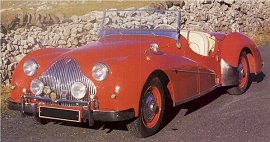 Only a handful of Alvis sports cars would be built after the war, such as the TB14 (above) and TB21 - both featuring “Panelcraft” bodies on a standard chassis.
Only a handful of Alvis sports cars would be built after the war, such as the TB14 (above) and TB21 - both featuring “Panelcraft” bodies on a standard chassis.
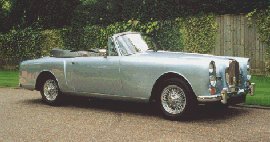 The Alvis TE21 Drophead Coupe was one of the prettiest cars of the 60's, except perhaps for the Facel Vega.
The Alvis TE21 Drophead Coupe was one of the prettiest cars of the 60's, except perhaps for the Facel Vega. |
World War 2, and German bombing, not only put an end to Alvis production, but nearly destroyed the marque completely when the factory was blitzed. Postwar Alvis models were the TA14 of 1947, and the TC21 of 1950, both of which were sedate, nicely-built touring cars. However a handful of TB14 and TB21 sports tourers, with “Panelcraft” bodies on the standard chassis, were made.
From
1950 onward, all cars were based on the TC21 chassis and 3 litre engine. With traditional, or with (from 1958) Graber styling, drop head coupe styles were available, but the days of the Alvis sportscar were over. Alvis were taken over by Rover in 1965, although there was one concept that almost made the light of day. Rover designed an advanced mid-engined sports coupe, using their own light-alloy 3.5 litre V8 engine, and in 1967 Alvis were considered as candidates to produce the car.
Then came the British Leyland formation, which involved Rover-Alvis, and this project was canceled. The 3.5 litre would be used in a handful of other sports cars, not the least of which was the wonderful TVR Tasmin.
Graber and Willowbrook Alvis
One of the post war Alvis to create quite a stir was the 4-5-seater cabriolet body on a 3-litre Alvis chassis exhibited at the Geneva Show in
1951 by Carrosserie Hermann Graber of Wichtrach, Berne. In
1952 a similar combination was shown; and the following year Graber produced a very attractive two-cloor four-seater saloon, again on the 3-litre Alvis. From these sprang the models which attracted so much attention at the London Motor Show in
1955 and
1956.
The simplicity of the exterior, the superb finish of the uphollstery and the furnishings were typical of the comparatively small firm of Graber; the beautiful lines of the hand-built body were in strong contrast with anything that previously had been placed on the Alvis chassis; and road experience showed that this Anglo-Swiss partnership produced comfort and a silence of running such as were seldom experienced.
The four-door saloon Alvis known as the Grey Lady was not shown at Earls Court in 1956, and it was decided by Alvis to concentrate on cars with Graber-built bodies. Later, in order to overcome import difficulties, some of the original wooden jigs were acquired from Graber, and arrangements made with the Swiss firm whereby Willowbrook Ltd., of Loughborough, could build the Graber-designed body in the UK.
Willowbrooks were then primarily manufacturers of bus and coach bodies; however, the same methods were employed to a great extent, and the sports saloon body gave the craftsmen who fashioned the big "public service" vehicles a chance to show what they could do in the world of automotive haute couture. In comparison with the stamped-out panels and pressings of the integral construction car body, a great deal of handwork and machined construction went into the building of a bus body. This experience and skill proved of great value when it came to producing the slim, stylish shell of the Alvis body.
The Graber jigs consisted of a timber former on which the front wings, wheel arches and
radiator cowling were shaped, and a similar jig for the rear wing structure. Both shells were made of 18 gauge sheet steel, and each was fabricated in halves. The four corner units were then hand beaten to shape to fit the jigs, and then the separate panels were welded together to form the front and rear structures. Before they were mated to the rest of the body, the exterior surfaces were filed and rubbed smooth to ensure that the even contours of the original design were obtained.
Similar methods were used to form the roof panels. The roof, like the bonnet top and luggage locker lid, was made of sheet aluminium. A timber "mock-up" in the form of the top portion of the body was used to ensure the correct shaping of the roof. It may be wondered why so much hand work went into the fabrication of the body panels; the answer was that in such a production job, where each body was virtually a "one-off" piece of construction, the capital outlay for steel dies and press tools could not be justified.
Thin Section Cast Alloy Window Frames
Apart from the front and rear wing structures, the first signs of the body taking shape were seen when the door and window frames mated up on a slave chassis frame, on which the body framework was built up before transfer to the chassis. Willowbrooks used thin section, cast alloy windscreen pillars in place of the original design of timber and metal and these were attached to the cant rails and windscreen top rail by sheet metal gusset plates.
The Alvis had box section chassis members, and there were four main cross members in addition to that which supported the front suspension; the body was secured at seven mounting points on each side, with pads of Balata belting to provide insulation. The door pillars and windscreen lower rail were attached to the stiff, fabricated front bulkhead, in which provision was made to house the
battery, heater and some of the electrics.
Immediately above the rear-axle line, the rear light frame was attached to the sheet metal structure of the wheel arches and luggage locker; it was only when this stage was reached that the car started to show off the beautiful lines of the body. As quiet as the Swiss-bodied cars were, Willowbrooks incorporated a main floor of tin, resin-bonded plywood to keep the road noise level even more subdued. Sheet metal was used for the floor aft of the cross member immediately in front of the rear axle. With the exception of the plywood floor section, which is protected from the
exhaust system by a heat shield, all the timber used is seasoned ash.
Progressively units which were fabricated elsewhere in the Willowbrook shop were placed in position. The single piece windscreen was a completely framed section, and not, as was usually the case, a piece of glass of the correct shape held in place by a rubber moulding strip. The frame, complete with glass, was secured to the body structure by steel plates and screws. The facia panel was unusual in that it was a glass fibre moulding.
The apertures for the instruments were incorporated in the moulding, which was reinforced by a bonded timber rail, making direct contact with the front bulkhead unit. Painted and polished, it was indistinguishable from the original Graber design. After the body structure has been completed but, of course, before the final trimming, painting was carried out. After an etching primer had been applied to key the paint to the bare metal, three coats of filler were put on each, rubbed down in turn until the whole surface of the exterior panelling wais dead smooth. At least four coats of the chosen colour were then applied.
What then appeared to be a showroom finish was completed with a thin mixture of colour, thinners and cellulose. After polishing, the result of all this was a blemish-free, mirror glaze which was not only a joy to look at, but which was durable. Anyone who has had the good fortune to travell in one of these cars will know that the seats were exceptionally comfortable. A sponge rubber overlay was placed on a spring case, and the whole covered in
Connoly leather. Where the leather is fluted, the flutes were packed with wadding. The result was to provide a seat which gave firm support where required, extreme comfort, and an air of luxury in the depth of cushion and appearance of the leather.
Trimming of the interior was to the same high standards as the coachwork. The doors and body sides were covered in matching leather, and the very close fitting carpet, which was laid over the whole of the floor, was also piped with leather. These cars were built only in small numbers. The craftsmanship of the Willowbrook was every bit the match of that from Graber - and either iteration remains highly collectable and sought after.
Recommended Reading: Lost Marques - Alvis (USA Edition) 


